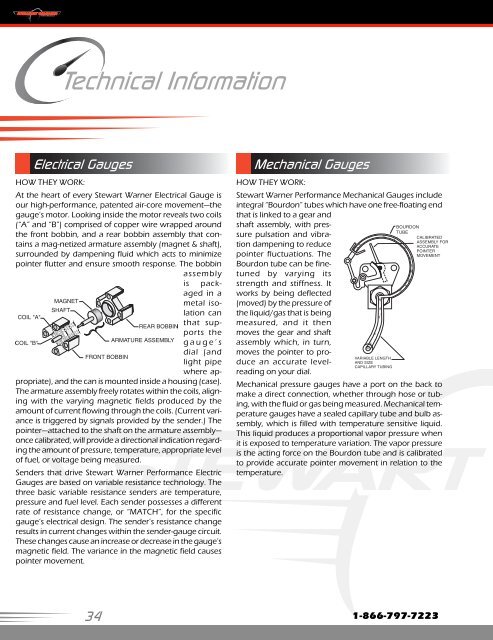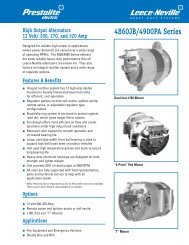Stewart Warner Performance Catalog - Auto Electric Service, Inc.
Stewart Warner Performance Catalog - Auto Electric Service, Inc.
Stewart Warner Performance Catalog - Auto Electric Service, Inc.
You also want an ePaper? Increase the reach of your titles
YUMPU automatically turns print PDFs into web optimized ePapers that Google loves.
Technical Information<br />
<strong>Electric</strong>al Gauges Mechanical Gauges<br />
HOW THEY WORK:<br />
At the heart of every <strong>Stewart</strong> <strong>Warner</strong> <strong>Electric</strong>al Gauge is<br />
our high-performance, patented air-core movement—the<br />
gauge’s motor. Looking inside the motor reveals two coils<br />
(“A” and “B”) comprised of copper wire wrapped around<br />
the front bobbin, and a rear bobbin assembly that contains<br />
a mag-netized armature assembly (magnet & shaft),<br />
surrounded by dampening fluid which acts to minimize<br />
pointer flutter and ensure smooth response. The bobbin<br />
assembly<br />
is packaged<br />
in a<br />
metal isolation<br />
can<br />
that supports<br />
the<br />
gauge’s<br />
dial (and<br />
light pipe<br />
where appropriate),<br />
and the can is mounted inside a housing (case).<br />
The armature assembly freely rotates within the coils, aligning<br />
with the varying magnetic fields produced by the<br />
amount of current flowing through the coils. (Current variance<br />
is triggered by signals provided by the sender.) The<br />
pointer—attached to the shaft on the armature assembly—<br />
once calibrated, will provide a directional indication regarding<br />
the amount of pressure, temperature, appropriate level<br />
of fuel, or voltage being measured.<br />
Senders that drive <strong>Stewart</strong> <strong>Warner</strong> <strong>Performance</strong> <strong>Electric</strong><br />
Gauges are based on variable resistance technology. The<br />
three basic variable resistance senders are temperature,<br />
pressure and fuel level. Each sender possesses a different<br />
rate of resistance change, or “MATCH”, for the specific<br />
gauge’s electrical design. The sender’s resistance change<br />
results in current changes within the sender-gauge circuit.<br />
These changes cause an increase or decrease in the gauge’s<br />
magnetic field. The variance in the magnetic field causes<br />
pointer movement.<br />
34<br />
HOW THEY WORK:<br />
<strong>Stewart</strong> <strong>Warner</strong> <strong>Performance</strong> Mechanical Gauges include<br />
integral “Bourdon” tubes which have one free-floating end<br />
that is linked to a gear and<br />
shaft assembly, with pressure<br />
pulsation and vibration<br />
dampening to reduce<br />
pointer fluctuations. The<br />
Bourdon tube can be finetuned<br />
by varying its<br />
strength and stiffness. It<br />
works by being deflected<br />
(moved) by the pressure of<br />
the liquid/gas that is being<br />
measured, and it then<br />
moves the gear and shaft<br />
assembly which, in turn,<br />
moves the pointer to produce<br />
an accurate levelreading<br />
on your dial.<br />
Mechanical pressure gauges have a port on the back to<br />
make a direct connection, whether through hose or tubing,<br />
with the fluid or gas being measured. Mechanical temperature<br />
gauges have a sealed capillary tube and bulb assembly,<br />
which is filled with temperature sensitive liquid.<br />
This liquid produces a proportional vapor pressure when<br />
it is exposed to temperature variation. The vapor pressure<br />
is the acting force on the Bourdon tube and is calibrated<br />
to provide accurate pointer movement in relation to the<br />
temperature.<br />
1-866-797-7223



